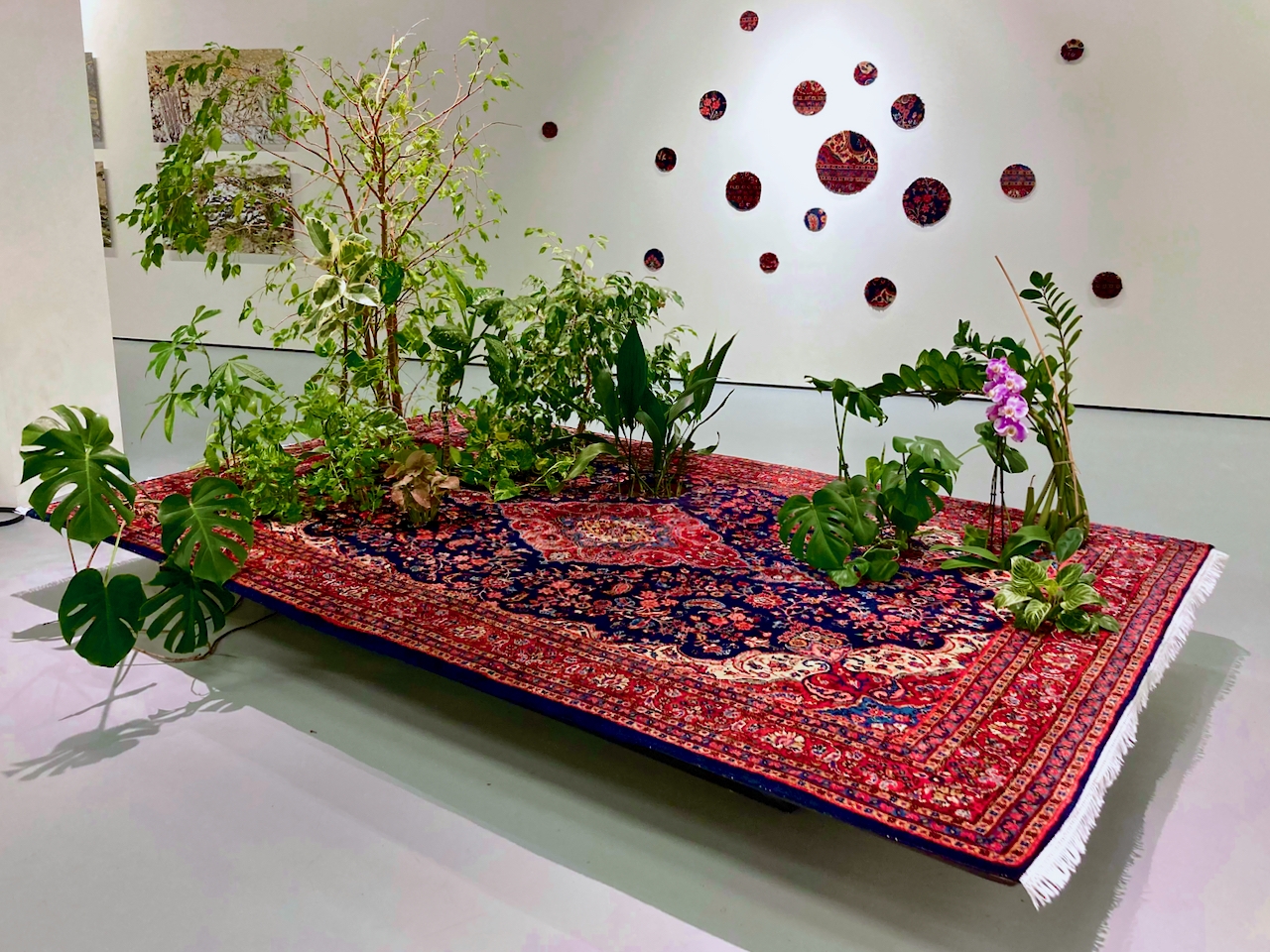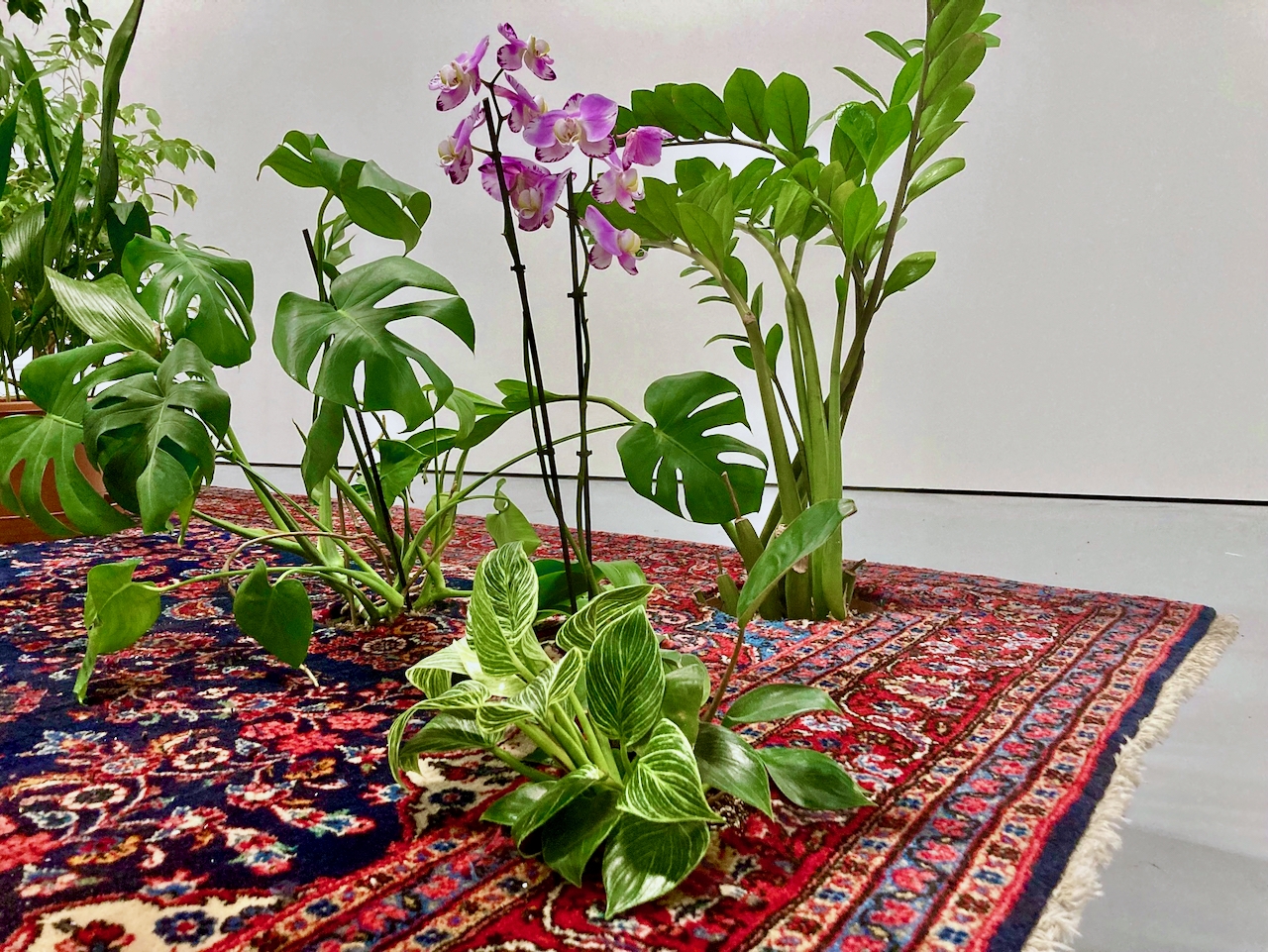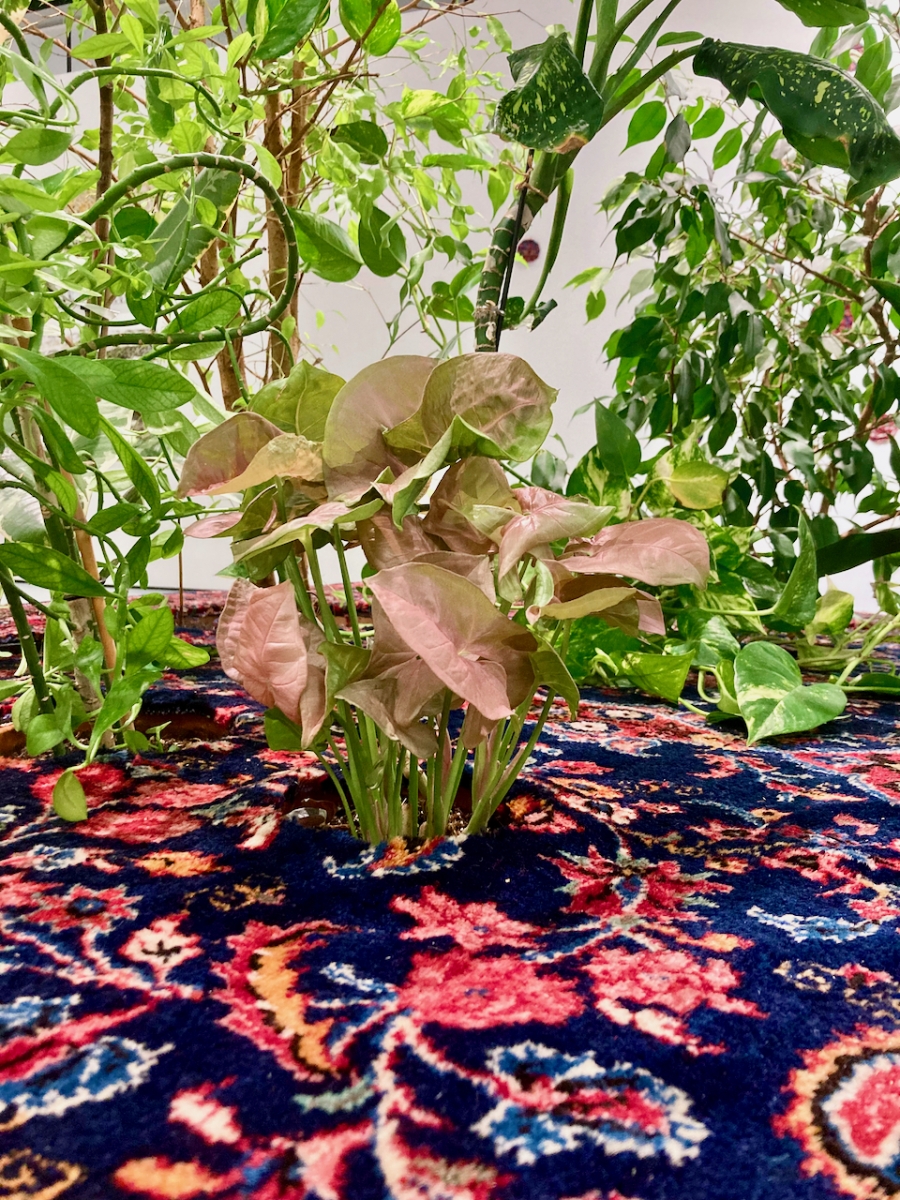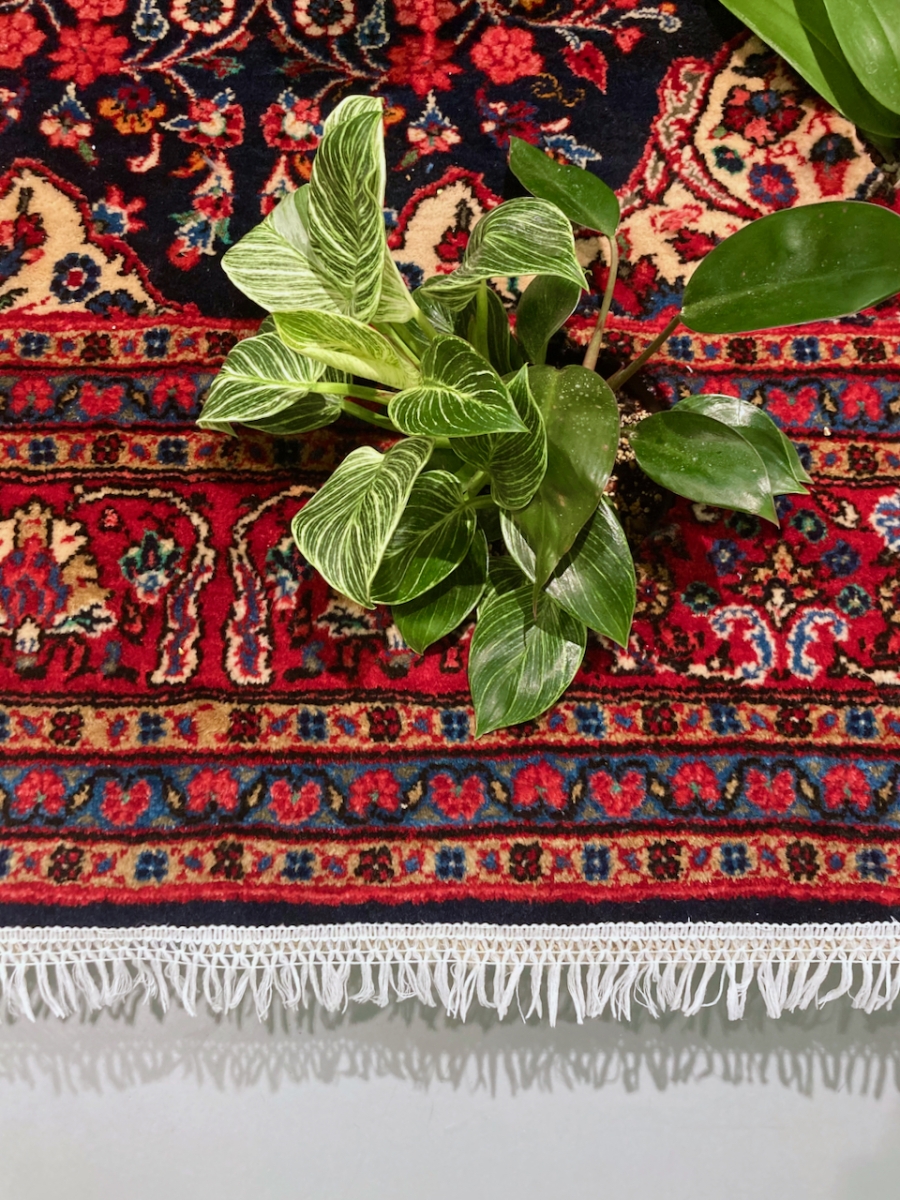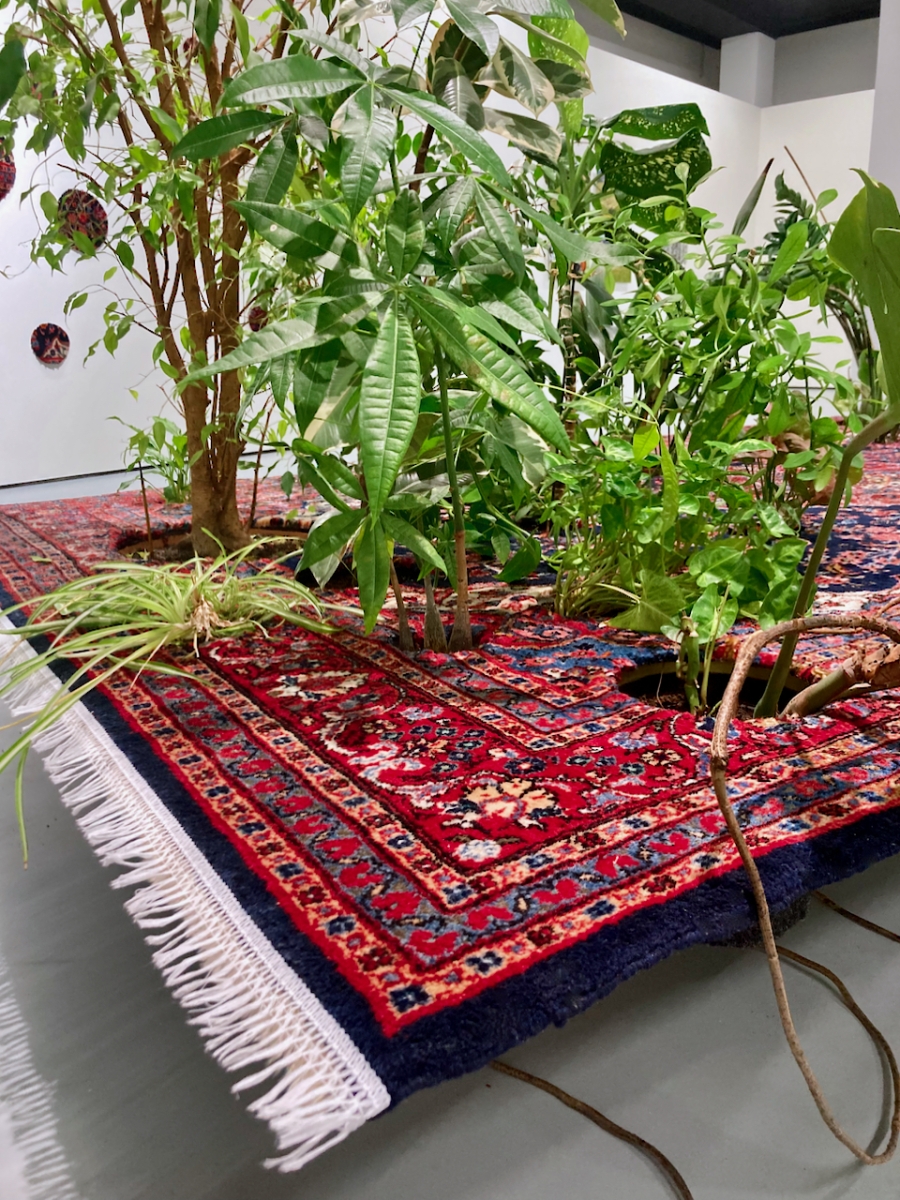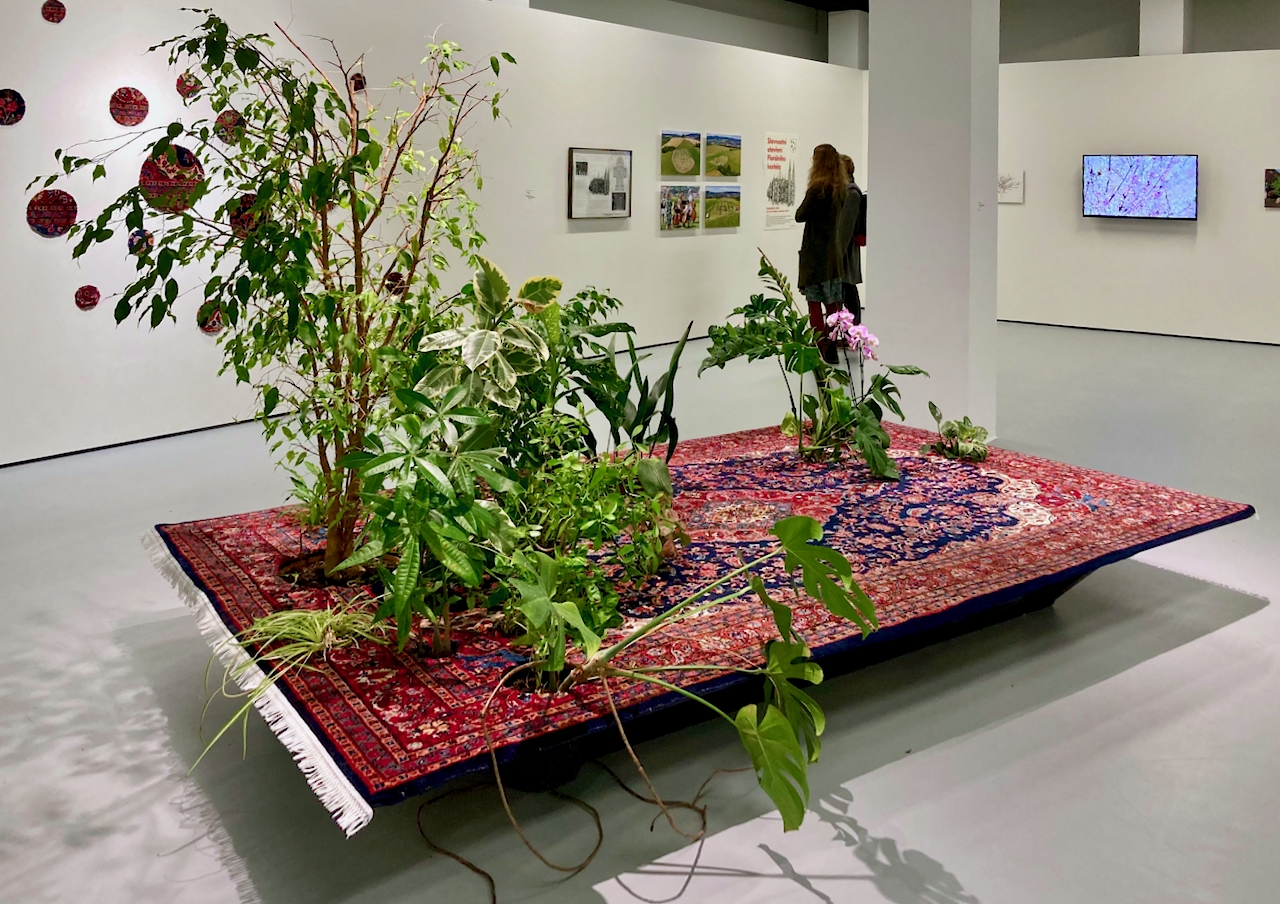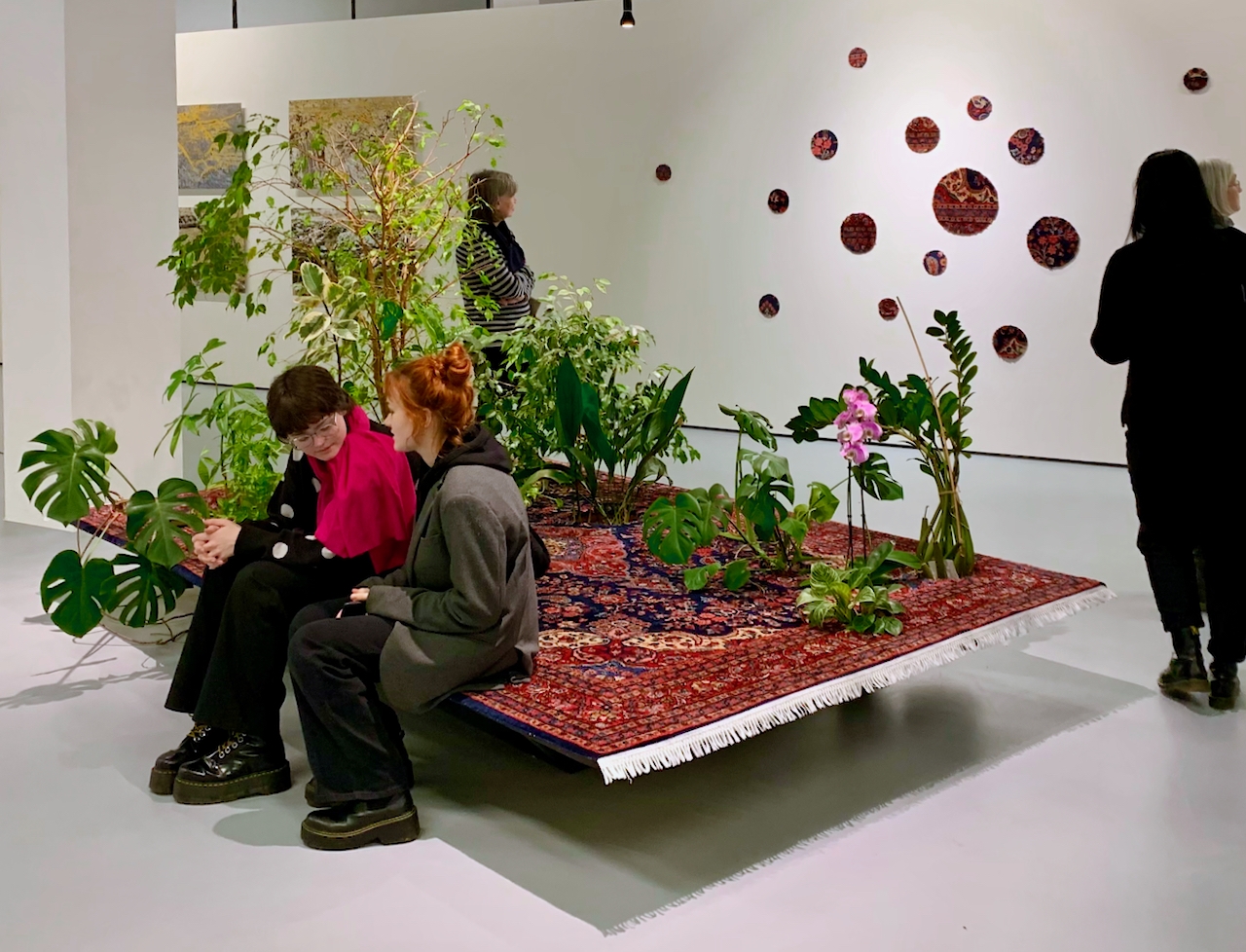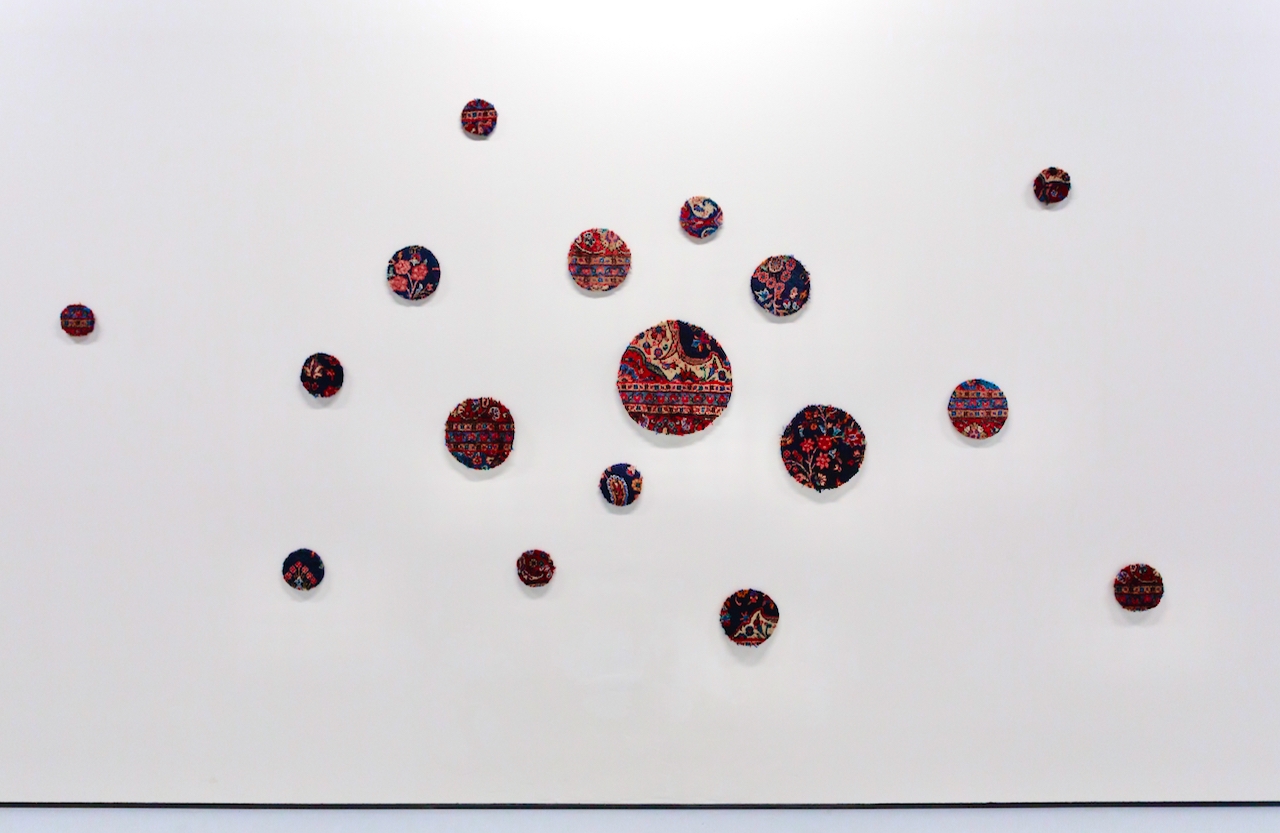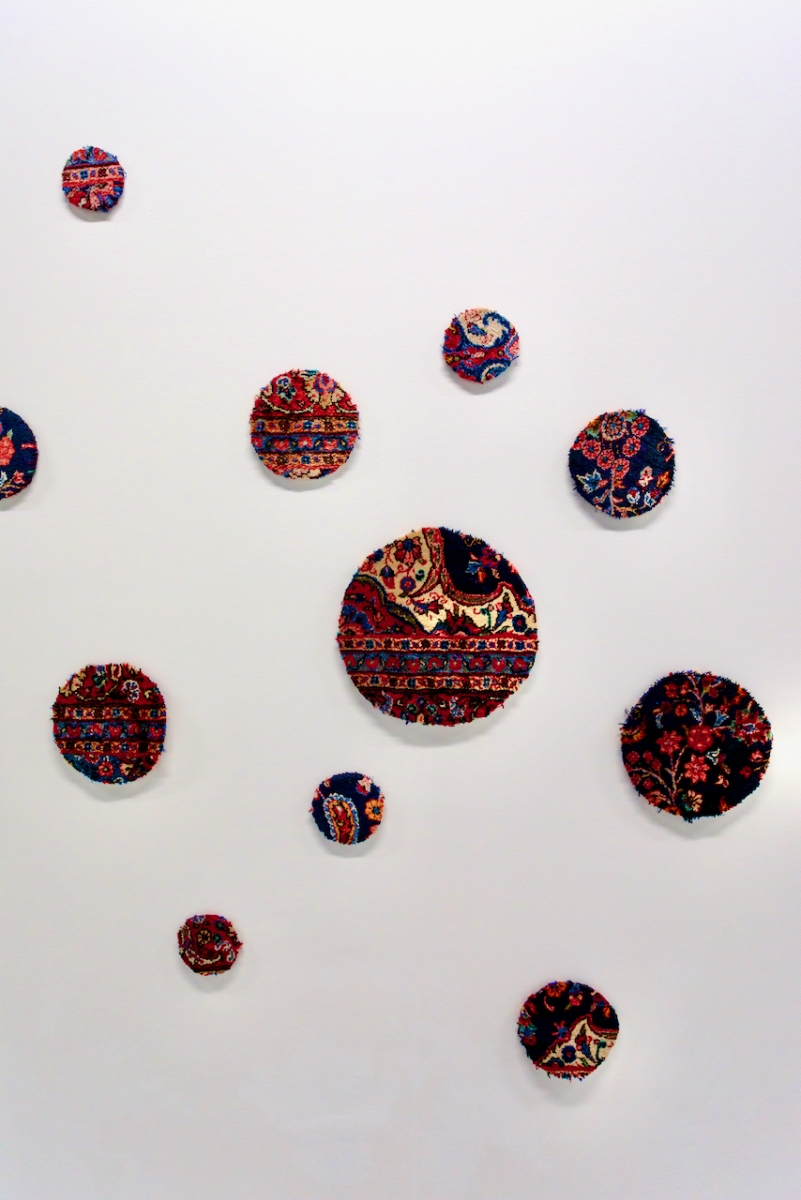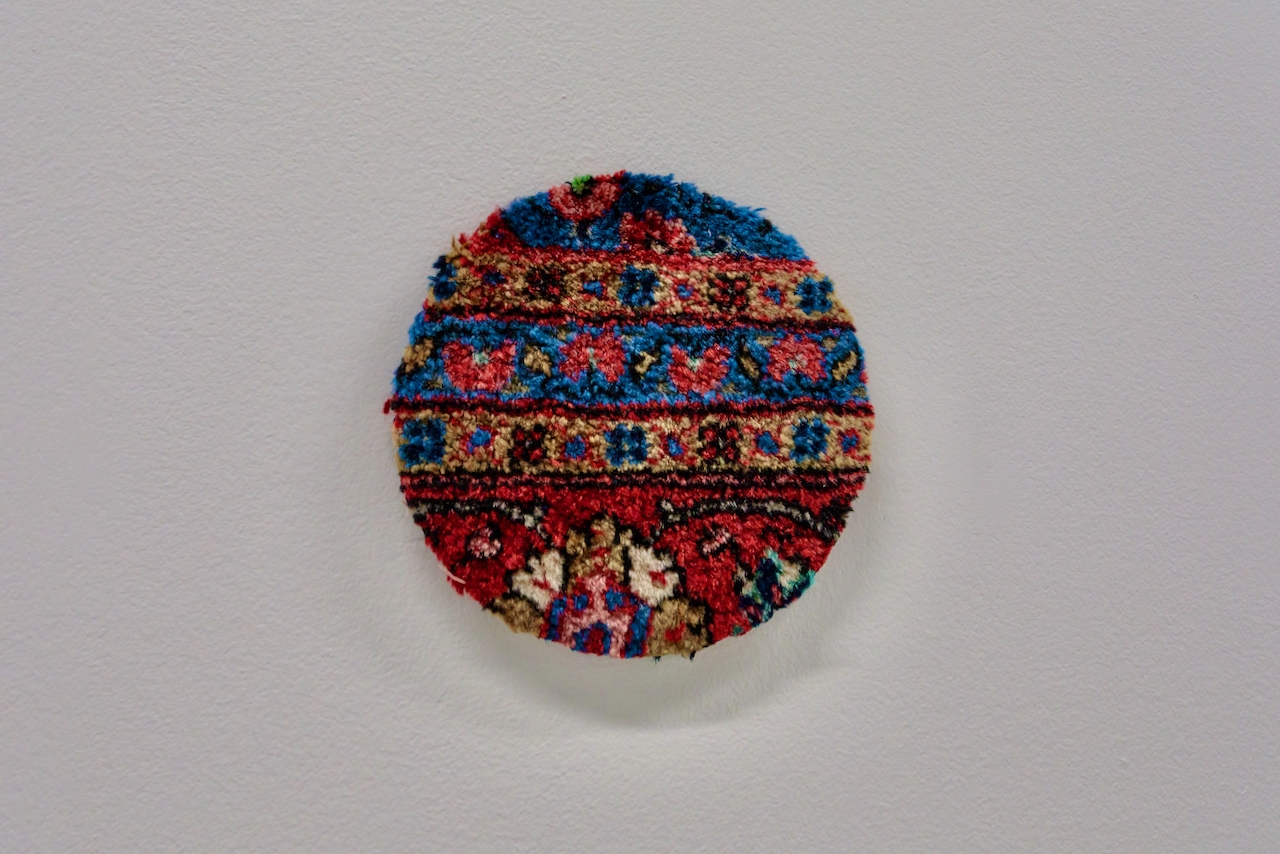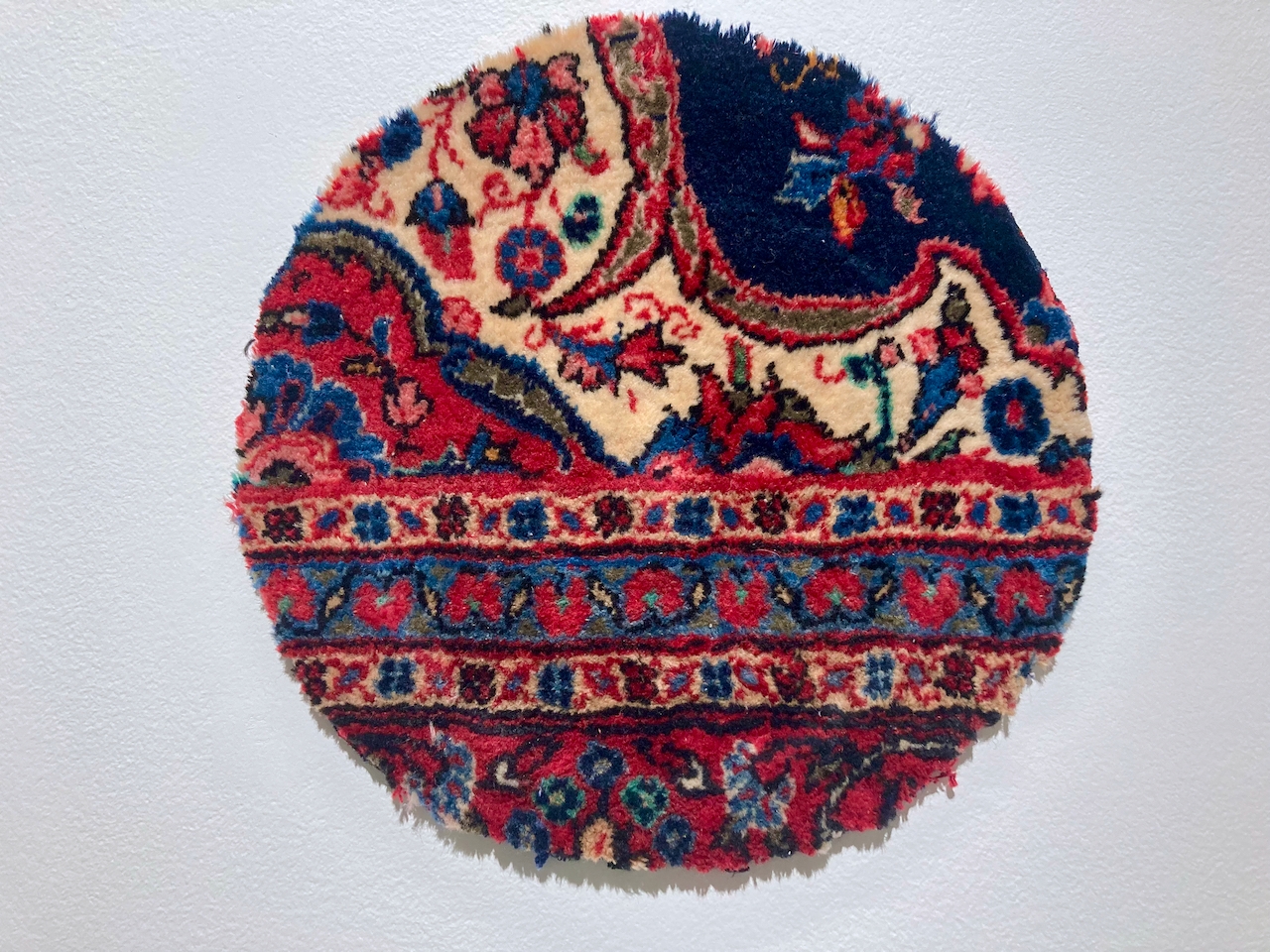CARPETORIUM: WILDERNESS OF HOME

Kristyna and Marek Milde, Carpetorium: Wilderness of Home, House of Arts Ústí nad Labem, 2022,
site-specific installation, oriental carpet, indoor plants borrowed by participants, 3m x 2m x 2m
“Carpetorium project connects the stories of plants with the stories of people, the ornament of the carpet intertwineds with the living flowers, and reminds us that the connection with nature is deeply rooted in us.”
The Carpetorium: Wilderness of Home project by Kristýna and Marko Milde, created for the exhibition GARDENING OF SOUL: INTRODUCTION in House of Arts (Dum umění Ústí nad Labem), explores how our common houseplants are important in creating a sense of home, rootedness in place, and belonging to nature. Houseplants, which we consider a habitual part of our lives, are not just mere decorations; they are an important part of our identity and the psychology of our homes. They are often cultivated and cherished for generations, they provide us with daily joy, comfort, and a sense of harmony. Combined with other domestic objects, they create new fictional ecosystems, and mental landscapes in an enclosed, alienated space of architecture. The Carpetorium installation reflects the contradictory relationship between nature and civilization while offering a model for connecting these two seemingly separate worlds.
Carpetorium: Wilderness of Home is a spatial installation that takes the form of a symbolic garden created from houseplants borrowed from various households. The floral collection thus assembled in this way serves as the source for a fantastical installation in which these plants grow through an ornamental “magical carpet”. Here people can sit, contemplate and view the plants from a new angle. The Carpetorium project connects the stories of plants with the stories of people, the ornament of the carpet intertwined with the living flowers, and reminds us that the connection with nature is deeply rooted in us.
Houseplants have their stories connected to the place and the people, those who donated to them or those who take care of them. They are silent witnesses to the events in our lives, they have often survived various hardships and relocations, or have literally outgrown their owners’ heads. In the microcosm of our homes, houseplants are part of the fantasy about nature, but at the same time, they provide an opportunity to cultivate sensitivity and awareness of the wider environmental context.
Houseplants are primarily native to remote, densely forested tropical regions, and are thus able to adapt to the shady and heated conditions of our homes. These plants therefore paradoxically represent islands of wild vegetation that we grow inside homes and that are now disappearing in nature. “Magical carpet” imaginatively transports the viewer between the domestic environment and the rainforest. In doing so, Carpetorium highlights the transcultural and intercontinental connection between tropical and domestic plants influenced by globalism and the consumerist style of our society.
The project included an open call, in which the artists invited local residents to participate in the project. Participants lent their houseplants and shared their personal stories with the artists. Thus, in the Carpetorium: Wilderness of Home installation, the worlds of homes thus intersect with the world of art to create, in mutual communication and understanding, a place – a “community garden” – where one can sit and reflect together on our relationship to nature.
The project follows Kristýna and Marek Milde’s installation Carpetorium: Lost and Found Gardens of Manhattan, MoCA Westport, 2021, created from houseplants found in municipal garbage on the streets of New York.
Carpetorium is part of a series of projects based on the idea of archives, collections, and categorization of information, in which Kristyna and Marek Milde explore environmental issues of the present.
Kristyna and Marek Milde
with the contribution of Michal Koleček
STORIES OF PLANTS
The project would not have been possible without the contribution of the people who kindly lent their houseplants for the installation.
We thank Kristýna Císařová, Adéla Van Laanen, Jana Matoušková, Ondřej Soukup, and Andrea Vaňourková and others.
Adéla Van Laanen, Klíše, Ústí nad Labem

I live in Klíš and plants are my lifelong passion… not only houseplants but also outdoor plants, flowers, trees, and shrubs… I grow everything possible and everywhere I walk/drive I look for something interesting to take home – fragments of twigs (cuttings) and seeds, and so I continue to expand the fauna around me. When I worked at my previous job, I had the greenest office in the building, thanks to the large windows I could have a small jungle. I gave my small plants to my colleagues on various occasions and managed to green up other offices and corridors as well.

Ficus benjaminus
I have the smaller Ficus benjaminus, half green, half variegated, as an inheritance from a colleague from the mentioned previous job. Under the weight of stress, she left overnight and never returned to work. And she did well. I believe he is now working in a calmer environment and is doing better. When I also left after that, Ficus went with me to a new job, where we are both happy.

Ficus benjaminus
The big Ficus benjaminus is in a very bad state right now, I need it to recover/regenerate a bit. It used to be bigger and thicker, but it got pimples, it fell out a lot and I had to cut it. He suffered from a lack of light at my place and began to wither.
I got it from a lady from Pustevna. I found it through an ad and gave it to my husband as our first tree together. We don’t have a garden yet and we don’t have a place to plant our own tree, so at least we have an indoor one. I hope one day to have more space… a house… ideally with a conservatory where my biggest ficus will be happy and do better.

Ficus elastica Tineke
The variegated Ficus elastica Tineke is my memory of Mrs. Marijke van Bommel and her blind dog from Greece. Marijke has an old boarding house in the village of Leveroy (Limburg, Netherlands), where she rents out rooms to foreigners who come there for seasonal work. I lived with her when I was on an internship in Heythuysen years ago. She had a big ficus in the restaurant near the boarding house and I took a small piece of it home.
Ficus elastica robusta, Monstera deliciosa
The green Ficus elastica robusta and the monstera deliciosa are my raised orphans from the local Kaufland. For a long time, I wanted my own Monster, like my grandmother in Moravia. I understand that she didn’t want to cut into her beloved plant to give me a piece, so I bought it from the store. So now we both have our own and no cutting.
Ficus elastica robusta was isolated on the shelf and in the discount. Sometimes I buy plants at a discount. I examine them, and when I judge that their case is not entirely lost, I take them home and nurse them until they are beautiful and healthy again. Sometimes I keep them, sometimes I give them as a gift to someone else.
 Pachira Aquatica
Pachira Aquatica
It’s my youngest piece. I bought it this summer at Tuincentrum Borghuis in Deurningen (NL). I like to go there to discover new pieces at a good price. I often take home a car full of plants instead of souvenirs. My parents once had a beautiful large Pachira tree with a braided trunk, but it dropped its leaves and they threw it away. To this day, I regret that I didn’t save her, because now I know that even if sometimes a plant looks like it’s gone, it may not be true. Their ability to regenerate is incredible. And with a little love and proper care, one can often create ready-made miracles.
Jana Matoušková, Ústí nad Labem
 Difenbachie
Difenbachie
Approximate age of the plant: 1 year
This diefenbachia is rescued from the trash, like many of my plants. I found her last year in the deadliest winter in our housing estate when a huge flower was peering into the distance from the garbage can. Unfortunately, the whole thing wouldn’t fit in our house, so I broke off at least a small part and took it with me to root.
 Syngonium podophyllum Pink (Neon)
Syngonium podophyllum Pink (Neon)
Approximate age of the plant: 2 years
There are two plants in the pot – I got one as a gift from a friend, just for fun. I took the other one from the plant exchange in Hraničář. Neither of them did very well at our house, the stump of both was left almost without leaves, and it only helped when I planted them both in one flower pot to save space.
 Philodendron birkin
Philodendron birkin
Approximate age of the plant: 2 years
I bought Birkin in a store as one of the few plants I have at home. I had a holiday at the time and flowers belong to the holiday, right? And if it’s a flower in a pot, I can enjoy it all year round.
 Epipremnum aureum (Šplhavnice zlatá)
Epipremnum aureum (Šplhavnice zlatá)
Approximate age of the plant: 2 years
There are several plants in the pot, one of them is a cutting from a plant that my mother has had in her kitchen for several decades, and I wanted to take a piece of it for my own kitchen. And she is accompanied by smaller plants that I took from the plant exchange that I have been organizing for 3 years in Hraničár.
Zamiokulkas (Kulkas zamiolistý)
Approximate age of the plant: 11 years
We found this plant in Brno in a shopping center as a broken twig lying on the ground. Today, my husband picked her up and jokingly told her that he had a “flower” for me. Větvička went with us to Ústí to the dormitory, lived in a glass of water for a year, where it took root and has been living with us ever since. It was our first flower in our common “household” and I have already divided it several times and given it to other people.
Photo: on the left epipremnum, on the right zamiokulkas
Ondřej Soukup, Střekov, Ústí nad Labem
 Monstera Deliciosa
Monstera Deliciosa
Bought a few years ago in Ikea, it is already divided into two parts. She’s my favorite monstera, I didn’t want to borrow her much, but what wouldn’t I do for art.
Andrea Vaňourková, Trnovany Teplice
Lopatkovec (Spathiphyllum)
Approximate age of the plant: 2 years
A donated flower for an office that does not meet local conditions. Still, it makes me happy every day. Now I will have to visit her at the exhibition.
